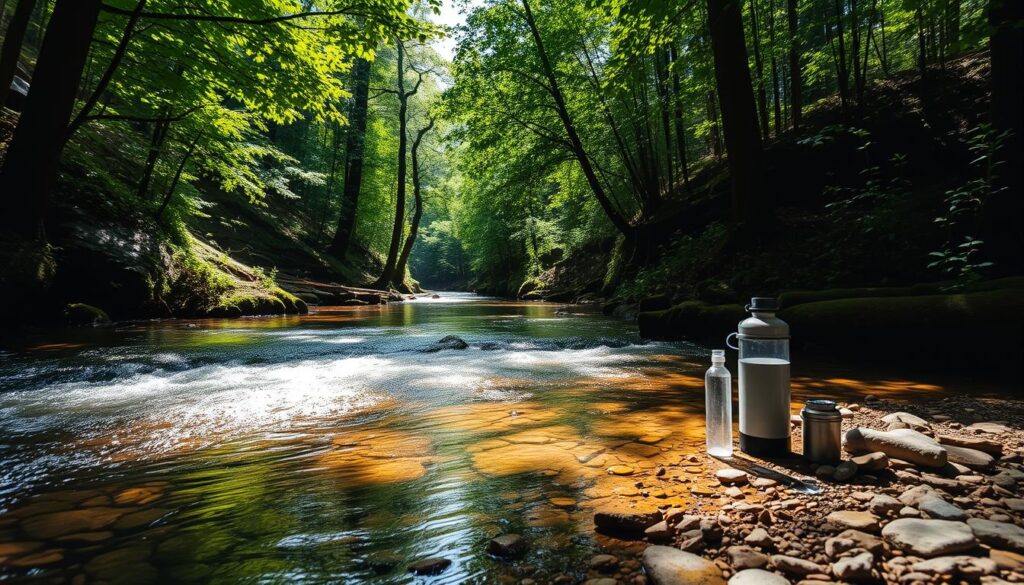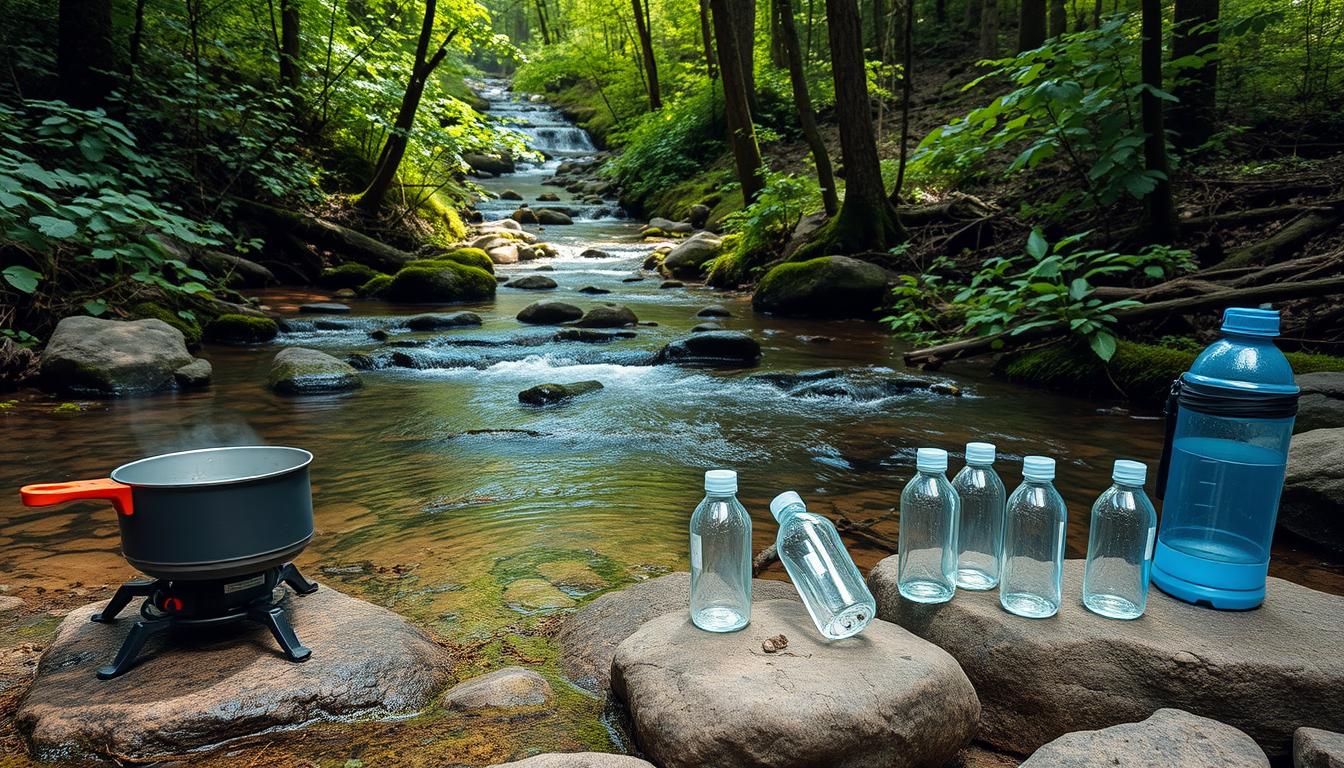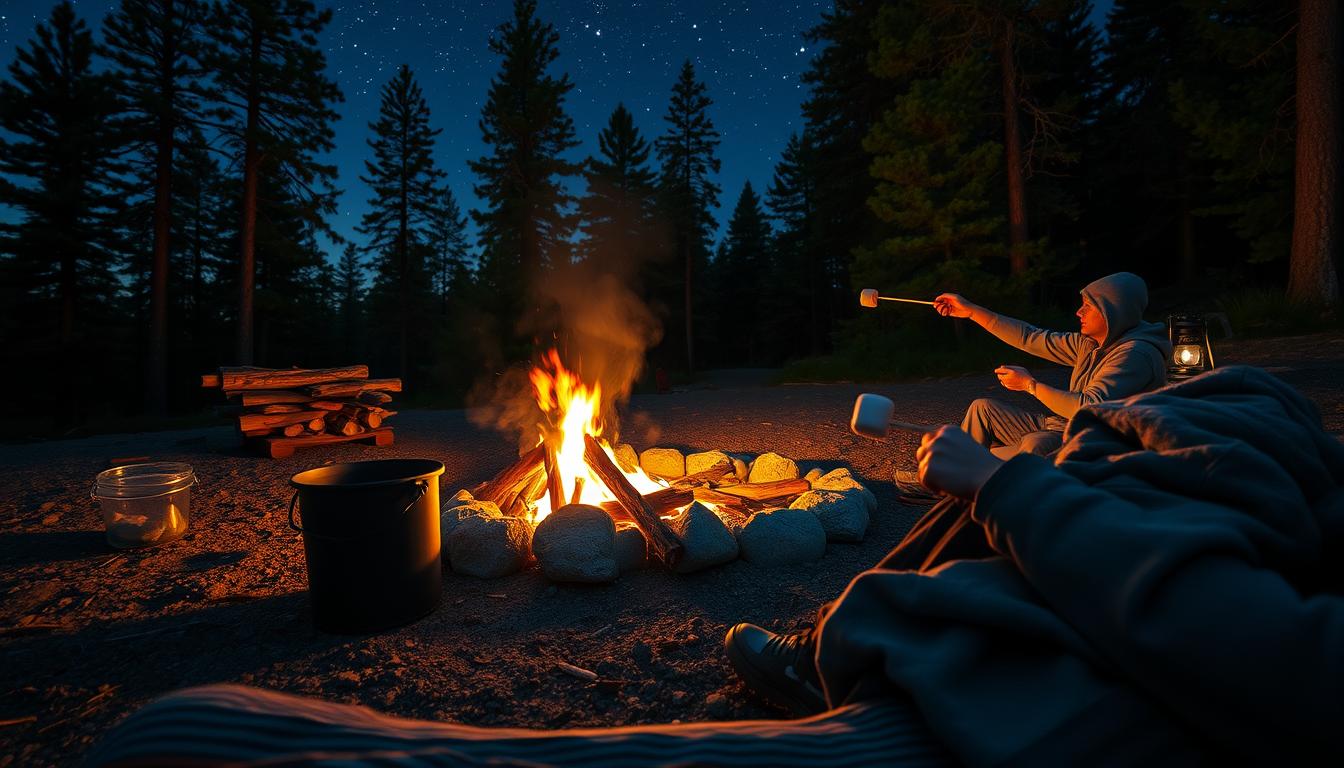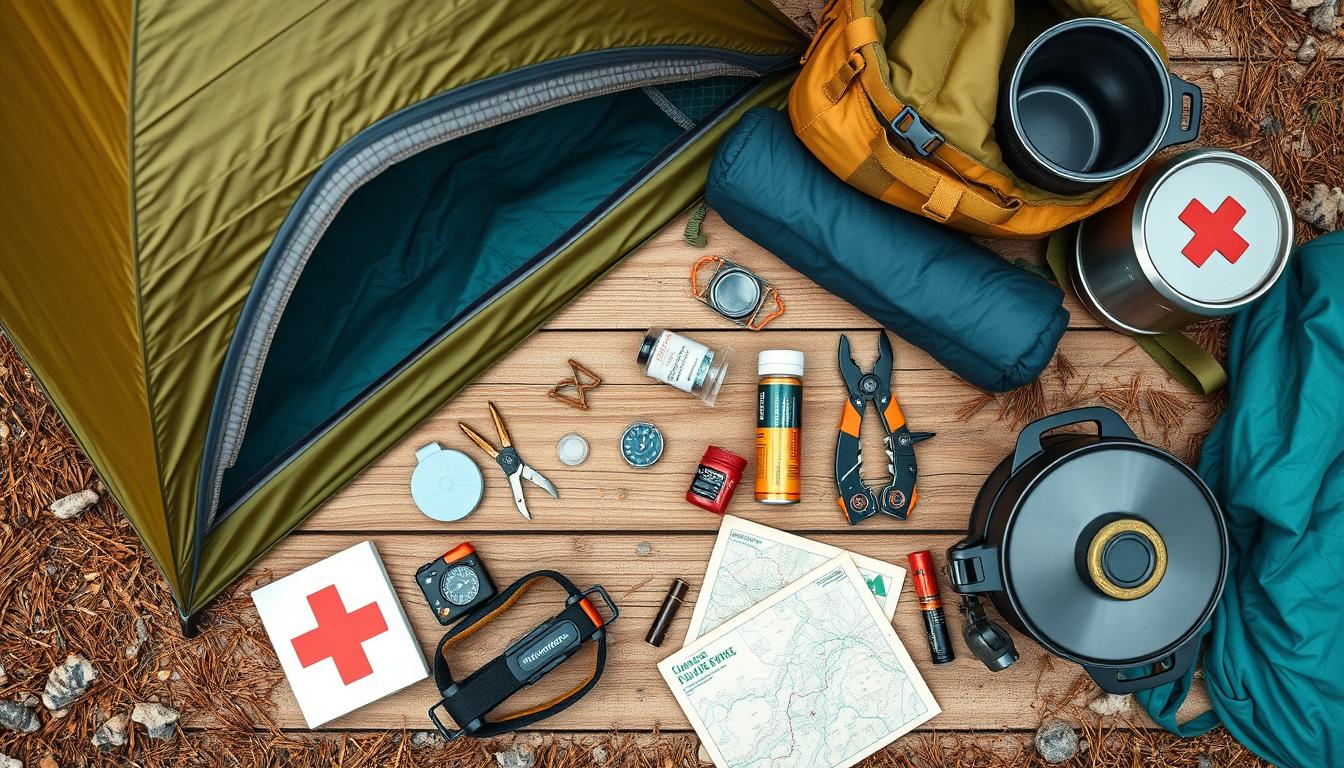When I go camping, I always make sure to purify water first. Clean water is not just a luxury; it’s a must for staying healthy. Drinking water that’s not purified can cause serious health problems.
This article will cover how to purify water while camping. I want to make sure I stay hydrated and enjoy the outdoors safely. The right way to purify water can really make a trip better.
Key Takeaways
- Purifying water is crucial for maintaining health during camping trips.
- Unpurified water may contain harmful contaminants.
- Research and choose the best camping water purification methods.
- Safe hydration is vital for outdoor activities.
- Being prepared can enhance my camping experience.
Understanding the Importance of Water Purification
When camping, it’s crucial to know how important water purification is. Drinking water that hasn’t been purified can be very dangerous. It can cause waterborne diseases from bacteria, viruses, and parasites.
These harmful organisms love to live in untreated water. So, it’s key to have safe water to drink while camping to keep myself healthy.
Camping often means going to places where clean water is hard to find. This makes it easier to get dehydrated, especially when I’m active. Having clean water is not just for drinking. It helps keep my energy up and makes me feel better overall.
Learning about camping water safety helps me choose the right water sources. This knowledge is very important.
Having the right tools to purify water makes camping better. It keeps me from getting sick and lets me enjoy the outdoors safely.
The Basics of Wilderness Water Sources
Exploring the outdoors means knowing about different water sources. Streams, lakes, and ponds are the main ones I find. Each has its own safety level and purity.
Streams have flowing water, which is less likely to have bad stuff in it. Lakes and ponds, on the other hand, can have still water. This makes them more likely to get polluted by animals or people nearby.
There are important things to look at when checking these water sources. How clear the water is is a big clue. Clear water usually means fewer germs.
I also watch how close these sources are to people or animals. Water near these areas might be more likely to be dirty.
- Streams: Usually offer flowing, fresher water.
- Lakes: Can have stagnant water, requiring extra caution.
- Ponds: Often home to a range of wildlife, affecting water safety.
Knowing the differences helps me choose the right water to purify. Learning about wilderness water sources is key for a good camping trip.
How to Purify Water While Camping in the Wild
When I go camping, knowing how to purify water is key for staying healthy. I’ve tried many camping water purification methods for different situations. Here are some effective techniques I often use.
Boiling water is a simple yet effective method. By boiling water for at least a minute, I can kill harmful bacteria. This is great when I have time to wait for the water to cool down.
Chemical treatment is another option. Using iodine or chlorine tablets lets me purify water without heat. It takes about 30 minutes to work. I use this when starting a fire is hard or water is scarce.
Filtration is also popular. Portable water filters can remove bacteria and other contaminants. They are easy to use and need little upkeep. I choose a filter based on its size and type, making sure it fits my needs.
Ultraviolet (UV) light purification is a more advanced method. UV light devices quickly kill microorganisms. Battery-operated models are handy for camping. But, water must be clear for UV light to work well.
| Purification Method | Effectiveness | Time Required | Equipment Needed |
|---|---|---|---|
| Boiling | High | 1-10 minutes | Stove, pot |
| Chemical Treatment | Medium | 30 minutes | Iodine/chlorine tablets |
| Filtration | High | Varies | Water filter |
| UV Light Purification | Very High | 1-2 minutes | UV light device |
The right method depends on my camping situation. I think about time, equipment, and water quality to pick the best way to purify water for my adventures.
Common Contaminants Found in Natural Water Sources
Exploring natural water sources, it’s key to spot common water contaminants. These can harm our health and affect how well water is purified.
Some common water contaminants include:
- Bacteria: Pathogens like E. coli come from fecal matter and can cause severe stomach issues.
- Viruses: Waterborne viruses can get into water from human or animal waste. They can be dangerous, even in small amounts.
- Chemicals: Pesticides, fertilizers, and industrial waste can get into water. They can harm our health over time.
- Heavy Metals: Lead, mercury, and cadmium can build up in water. They often come from mining or manufacturing.
- Sediments: Soils, organic matter, and debris can cloud the water. They may also carry harmful microorganisms.
Knowing about these contaminants helps me understand the risks. Different purification methods work better against some contaminants than others. It’s important to pick the right method for the contaminants in the water.
Best Water Filtration for Camping
Exploring nature means having clean water is key. The right water filter for camping can greatly improve your trip. It lets you drink from different sources safely. Knowing what to look for and which brands are top-notch helps make a smart choice.
Top Features to Look for in a Water Filter
When picking camping water filters, some features stand out:
- Flow Rate: A fast flow rate means quicker access to clean water, perfect for adventures.
- Filter Life: Long-lasting filters save money and reduce the need for frequent replacements.
- Size and Weight: Light and small filters are easy to carry and store.
- Ease of Use: Simple designs make setting up the filter quick, even in tough situations.
Recommended Product Brands
Several trusted brands offer quality water filters:
| Brand | Key Features | Recommended For |
|---|---|---|
| Katadyn | High flow rate, durable construction, long filter life | Backpackers and campers needing reliable filtration |
| Sawyer | Lightweight, versatile usage, easy maintenance | Solo travelers and lightweight gear enthusiasts |
| LifeStraw | Compact design, affordable, efficient in removing contaminants | Emergency kits and casual camping trips |
Portable Water Purification Devices
When I go outdoors, picking the right portable water purifiers is key. There are many choices, each suited for different camping needs. Knowing these options can make my water treatment on the go better.
Water bottles with filters are very popular. They let me drink from streams or lakes safely. These bottles are both effective and easy to carry, perfect for hiking and backpacking.
Portable UV purifiers are another great choice. They kill germs with UV light, need little upkeep, and are light. They purify water fast, so I can get moving quickly.
For groups or when lots of water is needed, compact pump filters are best. They’re a bit bigger but filter well and can handle many contaminants. This is great for camping trips where I need lots of clean water.
To pick the best portable water purifier, I made a comparison table. It shows the main features of each type:
| Device Type | Filtration Method | Weight | Purification Time | Ideal Use Case |
|---|---|---|---|---|
| Water Bottle with Filter | Activated Carbon & Hollow Fiber | 300-500g | Instant | Quick sips while hiking |
| Portable UV Purifier | UV Light | 150-250g | 2 minutes per liter | Solo trips or light hiking |
| Compact Pump Filter | Mechanical Filtration | 600-900g | 1-2 liters per minute | Group camping or longer trips |

Looking at these portable water purifiers helps me choose the best for my outdoor adventures. This ensures I stay hydrated and safe while enjoying nature.
Camping Water Treatment Options
When camping, it’s important to have safe drinking water. There are many camping water treatment options available. Each has its own benefits and drawbacks. Knowing these helps me choose the best one for my needs.
Chemical water treatment is a common choice. Chlorine dioxide tablets and iodine solutions are effective against pathogens. However, they can leave a bad taste and need time to work best.
Natural water treatment methods are also available. Solar disinfection uses sunlight to kill bacteria and viruses. I just need a clear container and sunlight for six hours or more. This method is slower but eco-friendly.
| Treatment Method | Type | Pros | Cons |
|---|---|---|---|
| Chlorine Dioxide Tablets | Chemical | Fast acting, portable | Aftertaste, requires wait time |
| Iodine | Chemical | Effective against viruses | Not suitable for pregnant women |
| Solar Disinfection | Natural | Eco-friendly, low cost | Time-consuming, requires sunlight |
Choosing the right camping water treatment depends on my camping spot and water source. Chemical treatments are quick, but natural methods are better for the environment. Finding a balance between convenience and safety makes my camping trips enjoyable and safe.
Wilderness Water Filtration Techniques
When I go into the wilderness, knowing how to filter water is key. It’s important for staying safe and hydrated. I’ve learned that trying different effective water filtering methods can really make a difference.
Gravity filtering is a well-known technique. It uses gravity to push water through a filter, making it easy and effective. You just need to set up a bag or container higher than where you want the water to come out. A good filter is essential, as it gets rid of harmful stuff, leaving water safe to drink.
Manual pumps are another good choice. They let me pull water from sources and filter it myself. I like how I can control how much water I filter. It takes some effort, but it’s reliable and works well in many places.
For a more advanced option, multi-stage filtration systems are great. They use different materials to clean water thoroughly. With charcoal, ceramic, and more, they remove almost all contaminants. I feel safe using them, especially in dirty water areas.
In short, using good water filters makes my outdoor trips safer and more fun. Whether I use gravity, manual pumps, or multi-stage systems, I know I’ll have clean water. This lets me enjoy nature without worry.
Purifying Stream Water While Camping
Understanding the flow rate of a stream is key to purifying its water. The speed of the water affects the amount of contaminants. Faster water usually has fewer bacteria and less sediment, making it better for filtration.
By watching the flow rate, I can pick the best times and methods for purifying water. This helps me stay safe and healthy while camping.
Understanding Flow Rate and Filtration
Flow rate is very important for water quality. A fast current means the water is likely safer to drink. On the other hand, slow-moving water can collect more debris and pollutants.
Using stream filtration techniques is crucial to ensure the water is safe. Some filters work better in fast-moving water, so I choose those spots.
Choosing the Right Location to Filter Water
Finding the right spot near streams is vital for safe water purification. I look for places downstream from pollution sources like campsites. Filtering water at least 200 feet away from camps or trails also helps keep it clean.
I often use natural barriers like rocks to improve water collection. This makes the filtration process more effective.
For more tips on purifying water while camping, check out this informative source. By following these methods, I can stay hydrated safely and efficiently.

Essential Tips for Safe Water Storage
When camping, keeping water safe is key to staying hydrated. Using the right containers is vital to avoid contamination. Look for BPA-free, durable jugs or collapsible bags made for water.
It’s important to keep purified water out of direct sunlight to stop algae growth. Make sure to seal containers tightly to keep out dirt and other contaminants. Labeling your water can also help in group settings.
Using water wisely is part of the fun outdoors. Keep track of your water usage to use it efficiently. Storing water in the fridge can make it cooler and more refreshing, reducing waste.
| Container Type | Features | Best Use |
|---|---|---|
| BPA-free plastic jug | Durable, lightweight, secure lid | Long-term storage, group outings |
| Collapsible water bag | Space-saving, portable | Short trips, hiking |
| Stainless steel canteen | Insulated, durable | Daily use, hydration on-the-go |
Following these tips helps me stay hydrated and healthy while camping. Good water management keeps my water safe and supports the environment.
Conclusion
Reflecting on water purification for camping, it’s clear that knowing different methods is key. We’ve looked at everything from filters to chemical treatments. This knowledge helps make sure our water is safe and clean.
Keeping water clean is crucial for safe camping. Whether I’m using a filter or chemical treatment, being ready is important. The right tools and knowledge help protect me from harmful contaminants.
Using these water purification methods makes my camping trips better and safer. I recommend these tips to anyone going camping. It ensures a safe and enjoyable outdoor adventure.





Leave a Reply